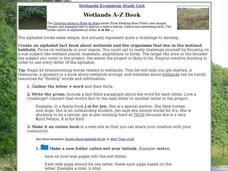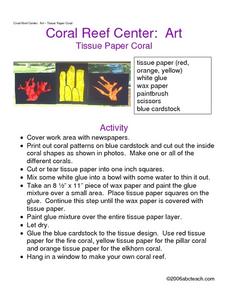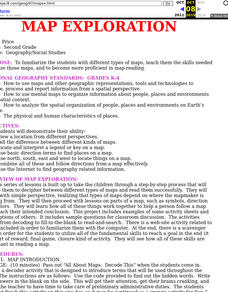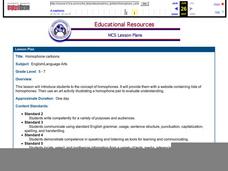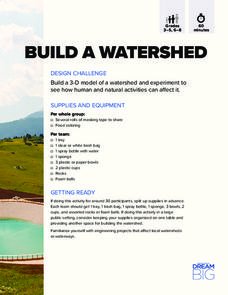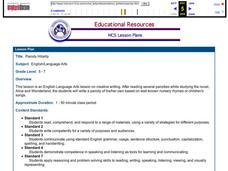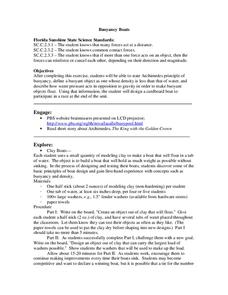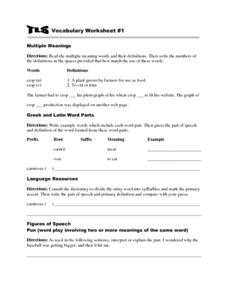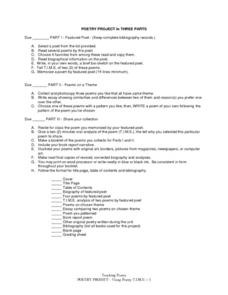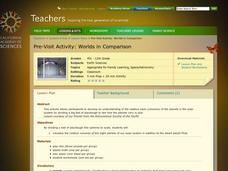Curated OER
Wetlands A - Z Book
In this wetlands worksheet, students follow directions on how to make an online a - z book about the wetlands. Students follow 5 sets of directions.
Curated OER
Shapes Galore!
First graders explore two-dimensional shapes. Individually, children follow directions to draw shapes. Learners use shaving cream, geoboards, yarn, marshmallows, and toothpicks to create shapes. As a class, 1st graders brainstorm...
Curated OER
Tell About Your Hero and Publish the Essay Online
In this writing about your hero worksheet, students read stories about personal heroes at an assigned web site that were written by other students. They think about their own hero, write an essay, and follow directions for publishing it...
Curated OER
Car Activities
For this math worksheet, students find cars in Auto Trader. They find the difference between the prices of the cheapest and most expensive cars. Students select a car they like and follow directions to buy on credit. Students complete a...
Curated OER
Lesson 12: Ho'olaulima: Let's Make a Hawaiian Garden
Second graders grow a classroom garden that acts as a living laboratory for cross-curricular activities. In this classroom garden lesson, 2nd graders follow directions to build and plant a garden that is used to teach math, science, and...
Curated OER
Splatter Spread
Young scholars assemble a potato cannon following directions. In groups, they analyze the spread pattern of paint soaked projectiles and discover the relationship between scatter and distance. They role play the role of a forensic...
Curated OER
Coral Reef : Art Tissue Paper Coral
In this coral reef art activity, students follow directions to complete a piece of art. Students use cardstock, tissue paper, and wax paper to make a beautiful picture.
Curated OER
America on the Move
In this transportation instructional activity, 3rd graders red short passages about different forms of transportation and how each evolved. students then answer 15 multiple choice and short answer questions with 1-2 questions following...
Curated OER
Fibonacci and the Golden Number!
In this math patterns worksheet, students review the beginning numbers in Fibonacci's numbers, find the pattern, follow directions and problem solve to find the Golden Number and complete a chart, measure lengths of body parts and find...
Curated OER
Map Exploration
Are you looking for a terrific instructional activity on map activities for your second graders? Then, this resource is for you! The activities range from decoding, to fill-in-the-blank, to read-and-search. There is a website activity...
Curated OER
Homophone Cartoons
A terrific lesson on homophones awaits your youngsters. First, pupils access a website that contains lists of homophones. Then, it's time to get creative! Everyone gets a piece of poster board and they create a homophone cartoon -...
Curated OER
"The Soil Around Us" Project
Young geographers collect samples of different kinds of soil to match to the soil terms in Barry Rudner's rhyming book Filet of Soil: dirt, mud, dust, soot, etc. They start a glossary for the project on index cards or large sheets of...
DiscoverE
Build a Watershed
What's the best way to learn how watersheds work? Build one! Combining engineering, the water cycle, and ecology concerns, the activity is the perfect fit for an interdisciplinary unit. Teams construct a model watershed with simple...
Baylor College
Modeling Earth's Atmosphere
Life on Earth is made possible by the unique composition of its atmosphere. Working collaboratively, a scale model is created as young scientists learn about the different layers of gas that surround the planet. Cards are included that...
Baylor College
Crossing the Synaptic Gap
As part of a unit on the chemistry of the brain, thinkers learn how chemicals work to transmit messages between individual neurons and how controlled substances impact the synaptic cleft. They do so by playing a dice-and-card game in...
Micron Technology Foundation
Forces of Motion: Rockets
Young scientists design a rocket to launch using Newton's Laws of Motion in order to discover for themselves the forces of motion.
Curated OER
Parody Hilarity
Upper grade and middle school writers study the art of parody. In this language arts lesson plan, learners study the work of Lewis Carroll, read and discuss parodies from the book, Alice in Wonderland, and construct their own parody...
Curated OER
Poetry Assignment
As the culminating activity in a unit study of poetry, class members demonstrate what they have learned about poetry by creating a notebook containing original poems they have written, published poems they enjoy, and analyses of these...
Center for Precollegiate Education and Training
Buoyancy Boats
What did the sea say to the boat? Nothing, it just waved. An inquiry-based lesson starts with a simple concept on the Archimedes Principle and challenges pupils to make something out of clay that floats. Then, they design an object out...
Pennington Publishing
Vocabulary Worksheet #1 & #2
These two worksheets cover several grammatical topics. Pupils work on words with multiple meanings, Greek and Latin word parts, word connotations, academic language, and more. The result is seven quick exercises that could be used...
Curated OER
Practice With Commas
The instructions say to put commas where they belong, and that is just what your class will do as they practice comma placement and use. There are 20 sentences in desperate need of commas and four extensions exercises where comma use is...
Teaching English
Poetry Project in Three Parts
It’s poetry T.I.M.E! Individuals use the T.I.M.E. format (T = Title, thought, and theme; I = Imagery and figurative language; M = music and sound; E = emotion) to study a poet, collect poems that have a similar theme, and create a...
Curated OER
Peter and the Starcatchers: K-W-H-L Strategy
Bookend your study of Peter and the Starcatchers with a KWHL centered around treasure and power. Pupils work in small groups to compile knowledge and questions and then revisit this chart after reading and research.
Pacific Science Center
Worlds in Comparison
Young astronomers follow a step-by-step procedure for dividing a lump of dough into parts, resulting in a scaled volume set of puny planets. Along with the printable directions is a template chart of planet names on which learners can...


